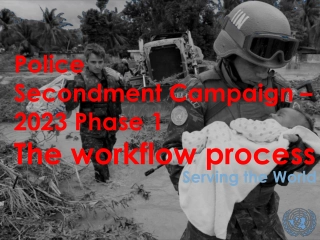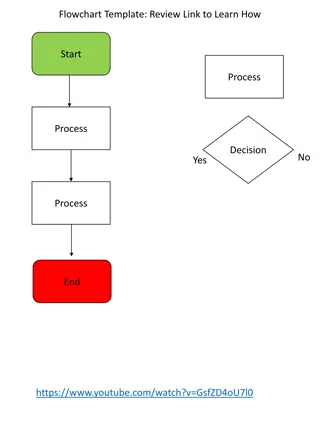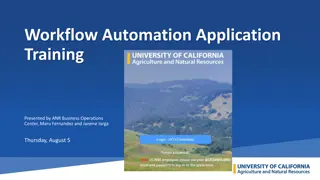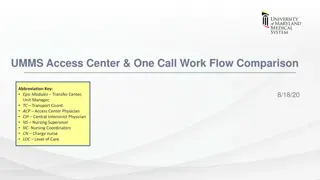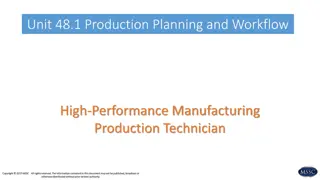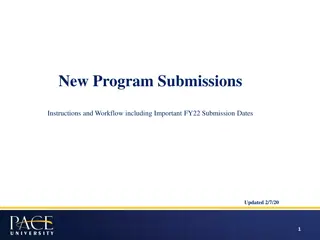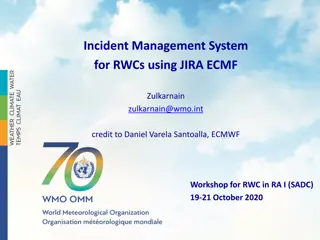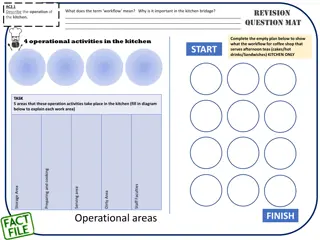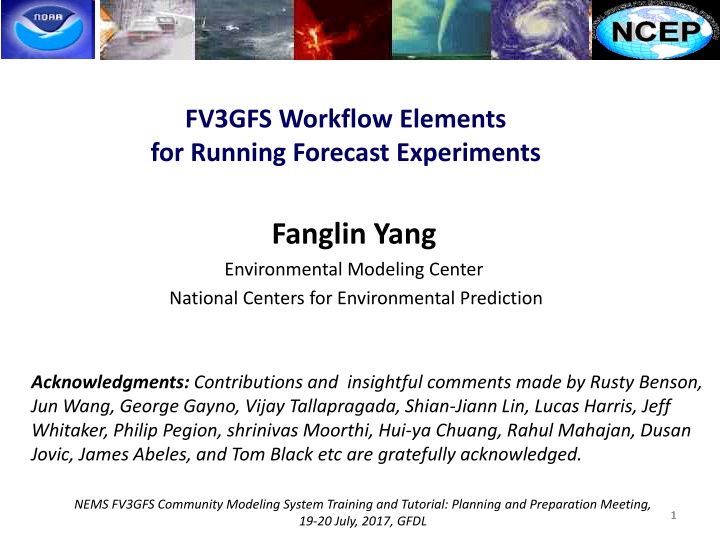
Running Forecast Experiments in FV3GFS: Workflow Elements & Tools
"Discover the comprehensive workflow elements and tools required for running forecast experiments in the FV3GFS environmental modeling system. Acknowledging contributions and insights from key individuals, this resource provides essential information on the NEMS FV3GFS community modeling system, superstructure SVN repository, scripts, source code, and more."
Download Presentation

Please find below an Image/Link to download the presentation.
The content on the website is provided AS IS for your information and personal use only. It may not be sold, licensed, or shared on other websites without obtaining consent from the author. If you encounter any issues during the download, it is possible that the publisher has removed the file from their server.
You are allowed to download the files provided on this website for personal or commercial use, subject to the condition that they are used lawfully. All files are the property of their respective owners.
The content on the website is provided AS IS for your information and personal use only. It may not be sold, licensed, or shared on other websites without obtaining consent from the author.
E N D
Presentation Transcript
FV3GFS Workflow Elements for Running Forecast Experiments Fanglin Yang Environmental Modeling Center National Centers for Environmental Prediction Acknowledgments: Contributions and insightful comments made by Rusty Benson, Jun Wang, George Gayno, Vijay Tallapragada, Shian-Jiann Lin, Lucas Harris, Jeff Whitaker, Philip Pegion, shrinivas Moorthi, Hui-ya Chuang, Rahul Mahajan, Dusan Jovic, James Abeles, and Tom Black etc are gratefully acknowledged. NEMS FV3GFS Community Modeling System Training and Tutorial: Planning and Preparation Meeting, 19-20 July, 2017, GFDL 1 1
FV3GFS Superstructure SVN Repository https://svnemc.ncep.noaa.gov/projects/fv3gfs/ /fv3gfs/trunk /bin/ exp/ exp_fv3gfs/ fv3gfs jobs/ scripts/ ush/ util/ docs/ exec/ fix/ modulefiles/ parm/ scripts/ sorc/ ush/ gfs_workflow.v15.0.0/ global_shared.v15.0.0/ gdas.v15.0.0/ (ENKF code and script)) gfs.v15.0.0/ (downstream jobs) https://svnemc.ncep.noaa.gov/projects/fv3/ NEMS FV3GFS only contains forecast model source code For most of the time, model developers only need to work on the FV3 project; Workflow team provides the infrastructure, utilities, pre- and post processing tools. 2
https://svnemc.ncep.noaa.gov/projects/fv3gfs/trunk/global_shared.v15.0.0/https://svnemc.ncep.noaa.gov/projects/fv3gfs/trunk/global_shared.v15.0.0/ USH Scripts fv3gfs_driver_chgres.sh fv3gfs_chgres.sh Source Code fv3nc2nemsio.fd/ fre-nctools.fd global_chgres.fd orog.fd regrid_nemsio.fd/ Nemsio_read/get.fd . script exglobal_fcst_nemsfv3gfs.sh.ecf exglobal_analysis.sh.ecf fv3gfs_remap.sh fv3gfs_remap_weights.sh Parm /parm_fv3diag diag_table diag_table_history variable_table.txt fv3gfs_nc2nemsio.sh fv3gfs_regrid_nemsio.sh fv3gfs_driver_grid.sh fv3gfs_filter_topo.sh fv3gfs_make_grid.sh* fv3gfs_make_orog.sh fix fields fix_fv3/ C1152/ C192/ C3072/ C384/ C48/ C768/ C96/ /parm_am . C768_grid.tile[1-6].nc C768_grid_spec.tile[1-6].nc C768_oro_data.tile[1-6].nc C768_mosaic.nc remap_weights_C768_0p125deg.nc remap_weights_C768_0p25deg.nc remap_weights_C768_0p5deg.nc remap_weights_C768_1deg.nc fix_am (sst, soil, vege, snow etc on Gaussian grid) fv3_SCRIP_C768_GRIDSPEC_lon3072_lat1536.gaussian.bilinear.nc fv3_SCRIP_C768_GRIDSPEC_lon3072_lat1536.gaussian.neareststod.nc 3
https://svnemc.ncep.noaa.gov/projects/fv3gfs/trunk/gfs_workflow.v15.0.0/https://svnemc.ncep.noaa.gov/projects/fv3gfs/trunk/gfs_workflow.v15.0.0/ para_config in ./exp_fv3gfs for running forecast-only experiments jobs scripts for running forecast-only experiments Rocoto-based workflow in ./fv3gfs for DA cycling (See Rahul Mahajan s presentation) submit_fv3gfs.sh para_config master config.fcst config.post config.vrfy config.arch config.nsst Fcst.sh Post.sh Vrfy.sh Arch.sh submit_fv3gfs.sh for running forecast-only experiment Users can use this script to run forecast-only experiments. It reads operational GFS or NEMS GFS initial conditions, converts them to FV3GFS cold start ICs, and submits forecast- only experiments. The workflow then runs post, vrfy and arch steps. Currently the workflow is controlled by psub and pend. The current workflow will be replaced by CROW (unified workflow) in the near future (see Samuel Trahan s presentation) 4
https://svnemc.ncep.noaa.gov/projects/fv3gfs/trunk/gfs_workflow.v15.0.0/https://svnemc.ncep.noaa.gov/projects/fv3gfs/trunk/gfs_workflow.v15.0.0/ para_config --master config . Set up environment and running directories .. # ------------------------------------------------------------- # settings that are used by more than one steps # ------------------------------------------------------------- gfs_cyc=1 # GFS cycles (00, 06, 12 and 18Z), defaults to 1 (00Z) cycle gdas_cyc=4 # number of GDAS cycles fseg=1 # number of AM forecast segments for gfs FHCYC=24 # Surface cycle calling interval fmax1=240; ; fmax2=384 for cyc in 00 06 12 18; do eval FHMAXFCST${cyc}GFS1=$fmax1 eval FHMAXFCST${cyc}GFS2=$fmax2 # maximum hour 2st segment eval FHMAXFCST${cyc}GDAS=9 # maximum forecast hour for GDAS eval FHOUTFCST${cyc}GFS1=6 eval FHOUTFCST${cyc}GFS2=12 eval FHOUTFCST${cyc}GDAS=1 eval FHZERFCST${cyc}GFS1=6 eval FHZERFCST${cyc}GFS2=12 eval FHZERFCST${cyc}GDAs=6 eval MFCST${cyc}GFS=$fseg #number of GFS forecast segmants eval MFCST${cyc}GDAS=1 #number of GDAS forecast segments done cdump=$(echo $CDUMP|tr '[a-z]' '[A-Z]') FHMAX=$(eval echo \${FHMAXFCST$cycn$cdump$nknd}) FHOUT=$(eval echo \${FHOUTFCST$cycn$cdump$nknd}) FHZER=$(eval echo \${FHZERFCST$cycn$cdump$nknd}) LEVS=65 # number of AM levels CASE1=C192 # 1st segment resolution (0-240 hr) CASE2=C192 # 2nd segment resolution (240-384 hr) CASE_ENKF=C382 # ENKF resolution CASE=$(eval echo \${CASE$nknd}) if [ $CSTEP = efmn -o $CSTEP = epos ]; then CASE=$CASE_ENKF; fi case $CASE in C48) DELTIM=3600; layout_x=4 ; layout_y=8 ;; C96) DELTIM=1800; layout_x=4 ; layout_y=8 ;; C192) DELTIM=900 ; layout_x=4 ; layout_y=8 ;; C384) DELTIM=450 ; layout_x=4 ; layout_y=8 ;; C768) DELTIM=225 ; layout_x=8 ; layout_y=16 ;; C1152) DELTIM=150 ; layout_x=8 ; layout_y=16 ;; C3072) DELTIM=90 ; layout_x=16 ; layout_y=32 ;; *) echo "grid $CASE not supported, exit" exit ;; esac #---if fdiag is given, it overwrites FHOUT fh00=$(echo $DELTIM 3600|awk '{printf "%f", $1/$2}') fdiag="$fh00,6.,12.,18.,24.,30.,36., REMAP_GRID=latlon #gaussian or latlon for using fregrid or regrid_nemsio for remapping 5
https://svnemc.ncep.noaa.gov/projects/fv3gfs/trunk/gfs_workflow.v15.0.0/https://svnemc.ncep.noaa.gov/projects/fv3gfs/trunk/gfs_workflow.v15.0.0/ Config.fcst .. IC_DIR=/gpfs/hps/ptmp/$LOGNAME/FV3IC/ICs if [ $REMAP_GRID = latlon ]; then DIAGTABLE=$BASE_GSM/parm/parm_fv3diag/diag_table else DIAGTABLE=$BASE_GSM/parm/parm_fv3diag/diag_table_history fi npes=$(( ${layout_x} * ${layout_y} * 6 )) tasks=$npes # number of PEs for 1st segment nth_f=2 # number of threads for AM forecast npe_node_f=$pe_node # number of pes per node for AM forecast task_per_node=$((npe_node_f/nth_f)) MODE=64bit TYPE=nh HYPT=off # choices: on, off (controls hyperthreading) COMP="prod" # choices: debug, repro, prod if [ ${HYPT} = on ]; then export hyperthread=".true." export j_opt="-j 2" else export hyperthread=".false." export j_opt="-j 1" fi FCSTEXEC=fv3_gfs_${TYPE}.${COMP}.${MODE}.x APRUN="aprun -n $tasks -N $task_per_node -d $nth_f $j_opt -cc depth .. # choices: 32bit, 64bit # choices: nh, hydro 6
https://svnemc.ncep.noaa.gov/projects/fv3gfs/trunk/gfs_workflow.v15.0.0/https://svnemc.ncep.noaa.gov/projects/fv3gfs/trunk/gfs_workflow.v15.0.0/ Config.post POSTSH=$BASEDIR/jobs/post.sh #post workflow NODES=4 #number of nodes for all post jobs if [ $CKND -eq 2 ]; then NODES=3 ; fi POST_MEMORY=3072 POSTJJOB=$BASEDIR/jobs/JGFS_POST.sh global_nceppost.sh and down-stream jobs POSTGPSH=$BASE_POST/ush/global_nceppost.sh POSTGPEXEC=$BASE_POST/exec/ncep_post npe_node_po=6 #number of tasks per node for UPP npe_po=$((NODES*npe_node_po)) #total number of tasks for UPP NTHRPOST=1 APRUN_NP="aprun -n $npe_po -N $npe_node_po -j 1 -d $NTHRPOST -cc depth" #------------------------------------------------------------------------------ #--use ESRL ESMF regrid tool to remap forecast 6- tile netcdf files to global Gaussian grids and to write output in nemsio format. REGRIDNEMSIOSH=$BASE_GSM/ush/fv3gfs_regrid_nemsio.s h ." #------------------------------------------------------------------------------- #--use GFDL fregrid tool to remap forecast 6-tile netcdf files to global lat-lon grids but still in netcdf format, then use NC2NEMSIO to convert to nemsio. REMAPSH=$BASE_GSM/ush/fv3gfs_remap.sh #remap 6-tile output to global array in netcdf REMAPEXE=$BASE_GSM/exec/fregrid_parallel master_grid=0p25deg #1deg 0p5deg 0p25deg 0p125deg etc .. GFS_DOWNSTREAM=YES #run downstream jobs GFSDOWNSH=../gfs_downstream_nems.sh GFSDWNSH=$USHDIR/gfs_dwn_nems.sh downset=1 npe_node_dwn=8 #number of tasks per node npe_dwn=$((NODES*npe_node_dwn)) nthread_dwn=$((pe_node/npe_node_dwn)) APRUN_DWN="aprun -n $npe_dwn -N $npe_node_dwn -j 1 -d $nthread_dwn cfp" 7
FV3GFS Input and Output Warm RESTART coupler.res fv_core.res.nc fv_core.res.tile$.nc fv_srf_wnd.res.tile$n.nc fv_tracer.res.tile$n.nc sfc_data.tile$n.nc Cold RESTART gfs_ctrl.nc sfc_ctrl.nc gfs_data.tile$n.nc sfc_data.tile$n.nc Where n=1,2, 6 Created by CHGRES using operational GFS IC as input Written out at the end of forecast Forecast history: latlon=grid atmos_4xdaily.tile$n.nc nggps2d.tile$n.nc nggps3d.tile$n.nc atmos_static grid_spec Forecast history: latlon=gaussian fv3_historyd.tile$n.nc fv3_history2d.tile$n.nc Written out at $fdiag interval Written out at $fdiag interval #---if fdiag is given, it overwrites FHOUT fh00=$(echo $DELTIM 3600|awk '{printf "%f", $1/$2}') fdiag="$fh00,6.,12.,18.,24.,30.,36.,42.,48.,54.,60.,66.,72.,78.,84.,90.,96.,102.,108.,114.,120.,126.,132.,138.,144.,150.,156.,162.,1 68.,174.,180.,186.,192.,198.,204.,210.,216.,222.,228.,234.,240." NFCST=$(echo $fdiag |awk -F '[\t,]' '{print NF}') ;#number of forecast output 8
FV3GFS Post-processing For Forecast For Data Assimilation 1. Fregrid is used to merge six netCDF 1. DA analysis increments are computed on files on tiles for each group to a file the Gaussian grid, converted to cubic grid on global lat-lon grid at 0.25-deg on tiles, and added back to the restart resolution files inside the model. 2. fv3gfs_nc2nemsio.sh is used to 2. A different diag_table_history table from convert the global netCDF file to forecast is used to produce diagnostic nemsio format (e.g. history files. Then gfs.t00z.atmf009.nemsio) fv3gfs_regrid_nemsio.sh is used to 3. NCEP_POST reads in the nemsio file convert six netCDF tiles to global Gaussian on lat-lon grid to produce products grid in nemsio format. for verification and downstream 3. NCEP_POST reads in nemsio files on applications. Gaussian grid to produce products 9
I/O and Post-Processing will change after NEMS FV3GFS Write Component is complete. Interpolation to Gaussian grid will be carried out within the Write Component using ESMF regridding tools. Final history output from the model can be in either nemsio or netCDF format 10
By Jun Wang NEMS FV3GFS write grid component The main task for the write grid component is to process forecast data and to write out forecast results. The data transferred to write grid component is in ESMF field, a self- describing data representation. It allows write grid component to perform independent data process without inquiring information from forecast component. The data transferred to write grid component can be on different grid from forecast grid component. The regridding is conducted through ESMF regridding function call. The weights for regridding is computed once, the data transfer is efficient. Inline POST processing can be called on write grid component to remove IO process in POST. 11
By Jun Wang Parallelization of NEMS FV3GFS write grid component PE1 PE2 nggps3df00 nggps2df00 PEm pgbf00 PE1 wrt grid comp FH=00 PE2 PE1 PE2 PE3 nggps3df00 FH=03 nggps2df00 PEm pgbf00 wrt grid comp PEn FH=x FCST grid component PE1 PE2 nggps3df00 nggps2df00 PEm wrt grid comp Forecast grid comp Parallel domain pgbf00 Write grid comp Parallel domain 12
Resolution, Physics Grid, and Run-time on Cray 10-d forecast, 3-hourly output, 3.75-minute time step, with IPDv4 C768, 13km, 3,538,944 points Hydro/ non-hydro precision threads nodes CPU (min/10day) Non-hydro 32-bit 2 64 100 Non-hydro 64-bit 2 64 148 Non-hydro 64-bit 2 144 80 hydro 64-bit 2 64 106 hydro 64-bit 2 144 62 T1534 NEMS GFS (~13 km, 3072x1536), 61 nodes, 73 minutes 13 13
Real-time forecast-only experiment C768, 64 Layer (top at 0.2 hPa) 32-bit dycore, non-hydro, non-mono Initialized with NEMS GFS analyses (include NSST) Four times daily Runs on Cray production machine white space 64 nodes, 2 threads; 240-hour forecast with 3-hurly output takes ~100 minutes to finish Post-processing uses 4 nodes, takes ~6 hours to complete www.emc.ncep.noaa.gov/gmb/wx24fy/NGGPS/fv3gfsb www.emc.ncep.noaa.gov/gmb/wx24fy/NGGPS/fv3gfs_rt 14

